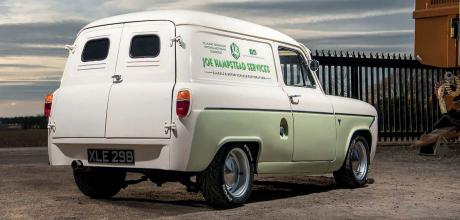Restomod 1959 Ford 300E
This Thames van project started out as a rotten shell with no interior or running gear. Over the course of nine years, it’s been raised from the ashes and reinvented in period restomod style.
Words Daniel Bevis
Photos Adrian Brannan
RIVER PHOENIX RESTOMOD THAMES 300E
This van project started out as a rotten shell with no running gear. Now it’s been raised from the ashes and reinvented in period restomod style.
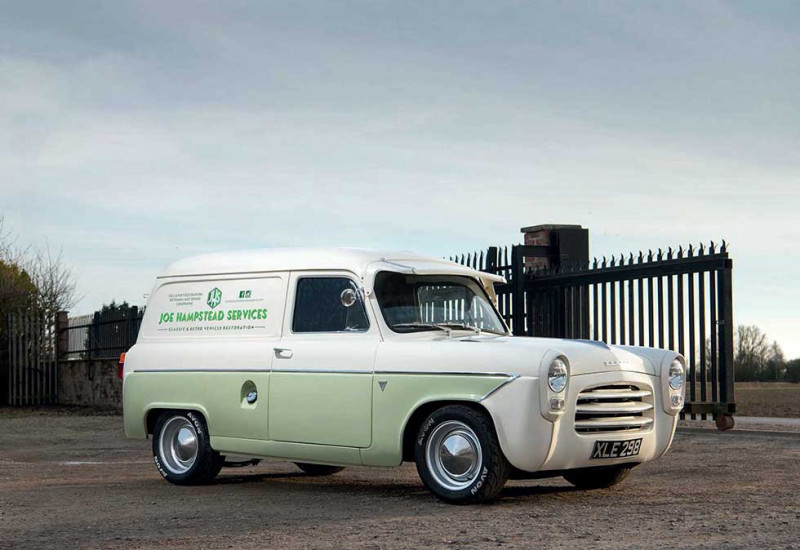
The term ‘restomod’ is a bit of a moving target, and it’s one that’s come to particular prominence in recent years, with the advent of high-end premium modernisations of classics by boutique specialists.
If you fancy dropping six-figures (or maybe more) on an old-school Porsche 911 with an ultra-premium interior, a much more powerful motor that’s also efficient and reliable, and 21st-Century brakes and suspension, you get on the blower to Singer. If Jaguar E-Types are your bag for the same type of treatment, it’s Eagle you should be calling. Alfaholics are your lads for a 105-series Alfa. And so it goes across the classic car spectrum — the Lancia Delta Integrale, the Ford Bronco, the MGB, they’re all getting the treatment right now.
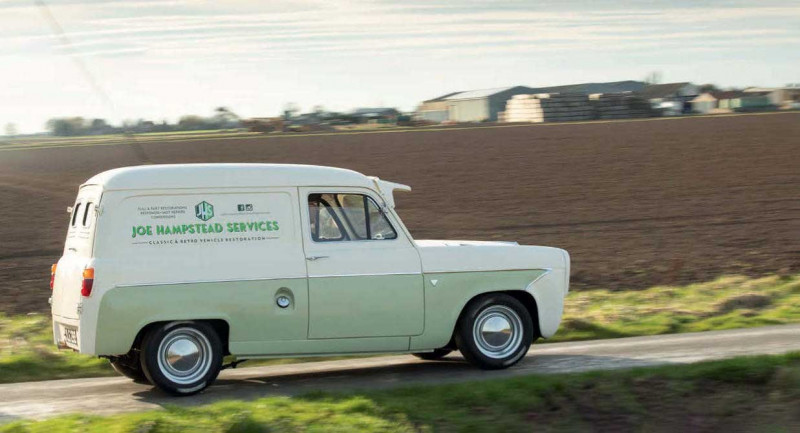
Of course, people have been doing this sort of thing for generations. Look at Joe Hampstead’s Thames 300E van here, and you’ll see restomod done in the classic style. It’s a fresh build, but it’s essentially done in a manner that could have been carried out in the 1960s. If your local plumber, greengrocer, carpenter or what-have-you fancied advertising the business with a bit of flair and panache, while also livening up their delivery rounds, they might have built something like what you’re looking at here.
“THERE WAS NO ENGINE OR ’BOX AND THE SHELL WAS ROTTEN IT WAS AN IDEAL BLANK CANVAS”
You see, creating a restomod doesn’t have to mean throwing hysterical amounts of money at a trimmer to cover your cabin in Harris tweed and Bentley-grade leather, or chucking in Lamborghini-shaming horsepower; the essence of the concept is to fit newer and more efficient technology into an older base in order to improve its dynamics and usability. Look at it this way: Joe’s van was built in 1959, and the Mk1 Escort was launched in 1967 — picture somebody smoking about in this van in the late-1960s, popping into the local Ford dealer for some service items, and getting chatting to the parts department about the availability of Escort disc brakes and rear axles; the conversation then turns to gearboxes and propshafts and crossmembers, and the whole thing starts to get very interesting…
In the present
That’s what Joe’s built here. A restomod in the classic style. “I’ve restored several cars in the past but this 300E was my first restomod,” he explains. “I initially bought the van as a birthday present for my dad, but due to him having other commitments, he didn’t have time to start it so I took it on myself. I’d done some work on a gentlemen’s car and he mentioned that his dad had the van for sale; I went to have a look at it and I bought it — there was no engine or gearbox, no interior, and the shell had been partially media-blasted and was very rotten.”
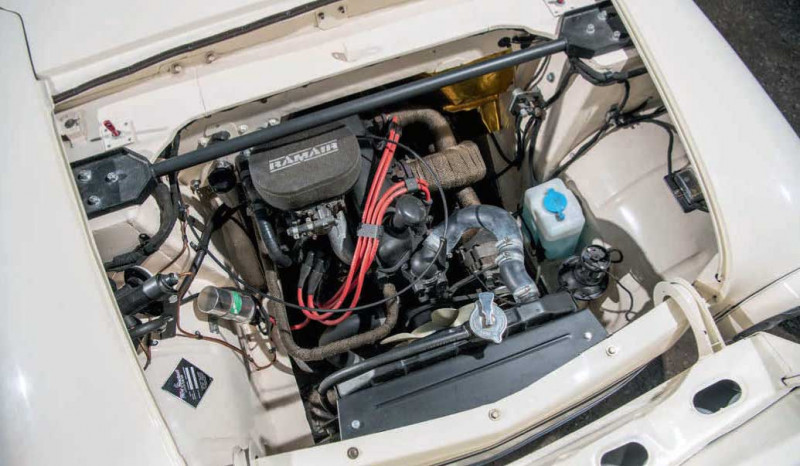
The perfect blank canvas then, and the more Joe looked at it, the more a vision began to form of how it could turn out. It might have been tempting to do a straight resto if it had been a matching-numbers example (or, indeed, if there was anything at all left of the trim), but with a crumbly base and few puzzle pieces to slot together, Joe was granted the gift of free rein. He could build whatever he wanted. And he wanted to build something that was brimming with old-school charm.
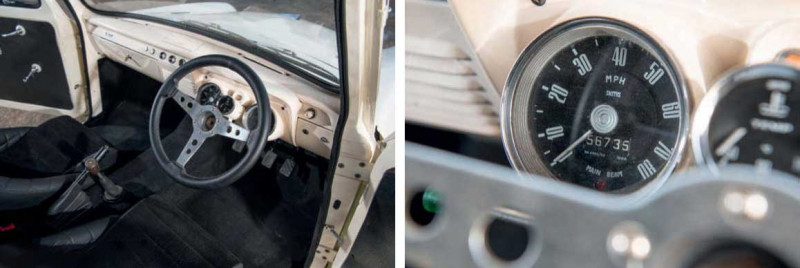
With an arsenal of hard-earned skills in his back pocket and a vibrant history of fiddling with old Fords, Joe was very well placed to get stuck in. You’ll no doubt have noticed the van’s signwriting, advertising his services in ‘classic and retro vehicle restoration’; he’s been a professional welder for 30 years, and the parade of Fords all began with his first car, a Mk3 Escort, going on to encompass the likes of the XR2, XR3 and XR3i, plus a Series 2 Escort RS Turbo and several Mk1 Escorts. And why did he choose a 300E this time? Quite simply because he’s always liked the look of them, and you don’t see many about.
In the gutter
“When I first started the restoration, I wanted to do as much of the work on it myself as I could,” Joe continues. “I began by stripping the remaining paint and filler off the shell, and then made a start with the welding repairs — it was rotten in all the usual places. One of the most time-consuming jobs was repairing the guttering, and I also spent days just trying to get the door gaps absolutely right.
The more we talk to Joe, the more it becomes evident that the quality and attention to detail is a matter of particular pride for him. ‘Good enough’ could never be good enough, and while it is possible to acquire pattern and repro parts for a vehicle like this, that just isn’t his style. Not for the image of period commercial perfection he’d envisaged. “I made as many repair panels as I could myself,” he assures us, “including both rear outer arches, the rear valance, wing repair panels… I only bought a pair of outer sills, everything else I made here in the workshop. Once the shell was all complete, I was originally going to paint the van one colour — but when I painted it all in Ivory, it looked a bit bland, so I decided to add Ford Lime Green to the bottom half.” The side decals came courtesy of Hutsons of Boston, and they help to sell the story to potential punters, while the wheels are a bit of a giveaway that all is not as it may seem beneath the skin: rolling on a set of staggered Lotus Cortina steels with banded rears, the aesthetic writes a cheque that the tech specs can readily cash.
Under the bonnet we find a 1700 Crossflow, packing such juicy upgrades as a big-valve head, fast road cam, Weber twinchoke carb, and a stainless exhaust system with tubular manifold. “My dad rebuilt the engine, and my friend Dave Brooks helpedme with the alternator conversion,” says Joe. And as you’d expect, this revvy little screamer is joined by a whole host of upgraded supporting mods: the shortened Mk1 Escort propshaft was balanced by a local company, mated to a three-rail 2000E gearbox going back to a Mk1 Escort axle that’s been narrowed by 100 mm. The braking system has been comprehensively upgraded, with Mk1 Escort discs and drums at front and rear respectively, along with a remote servo and braided lines.
The chassis set-up is a million miles away from the 300E’s utilitarian roots, sporting coil-overs at the front and a Mk1 Escort crossmember, along with adjustable TCAs and front anti-roll bar; there’s a Mk1 Escort steering rack too, and out back we find 50 mm lowering blocks, anti-tramp bars and a Panhard rod.
“It’s been a labour of love, taking around nine years on-and-off to complete,” says Joe. “Everything I could do, I did — the bodywork, paint, interior, and the modifications including a stainless steel fuel cell, stainless exhaust system, front strut brace, narrowing the rear axle, modifying the front crossmember, banding the wheels…” It’s an in-depth list, all showcasing Joe’s impressive skillset, and it all plays to the nature of what a restomod entails.
Joe’s considering fitting electric power steering in the future, and there are always other ideas swirling about — but for now, this is a glorious sepia-tinged vision of late- 1950s commercial motoring, reinvented in a late-1960s style. The fact that it’s been built this way in the 2020s keenly demonstrates just what a moving target the concept of restomod is.
Steel sunvisor is almost obligatory fitment, but there’s no denying it looks superb. Now it’s on the road, the van serves as the perfect runaround, and the ideal advert for Joe’s skills.
Tech Spec
- Body 1959 Ford 300E, steel sunvisor, steel 3-bar grille, de-bumpered, chrome doglegs and door mouldings, P700 headlights, locking bonnet pins. Paint: custom two-tone paint in Ivory over Ford Lime Green, decals by Hutsons Ltd, Boston
- Engine 1700 Crossflow, big-valve head, fast road cam, Weber twin-choke downdraft carburettor, Ramair filter, electronic ignition, tubular steel manifold, stainless steel exhaust system, alternator conversion, custom stainless fuel cell
- Transmission Three-rail 2000E gearbox, shortened Mk1 Escort propshaft
- Suspension Front: coil-overs, Mk1 Escort front crossmember, adjustable TCA, front antiroll bar, Mk1 steering rack. Rear: 50 mm rear lowering blocks, antitramp bars, Panhard rod, Mk1 Escort rear axle narrowed 100 mm
- Brakes Front: Mk1 Escort discs, Mintex pads. Rear: Mk1 Escort drums. Remote brake servo, braided brake lines throughout
- Wheels and tyres 5.5x13 inch Lotus steels, rears banded to 6.5x13, with 185/55R13 Avon ZZS tyres
- Interior Three-spoke steering wheel, classic bucket seats, three-point seatbelts, sound deadening and carpets
- Thanks To my dad, Graham, for rebuilding the engine and the continued use of his workshop, Dave Brooks for helping with the wiring, Julian at Pop Parts Plus, Hutsons Ltd, and Kerry, my girlfriend, for putting up with me spending hours at the workshop
13 inch steels have been widened to 6.5 inches at the rear to fill the van’s arches. Van’s bed is now a lot plusher than when it first rolled out of the factory.
ALL IN THE FAMILY
GENERATION ESCORT
There’s a lot of Mk1 Escort under the skin of Joe’s 300E, and that all makes perfect sense in terms of creating a period restomod. The Thames 300E van was built from 1954-1961, and it shared its fundamental bodyshell and engine with the Ford Squire – a two-door estate derivative of the 100E saloon. A lower trim level of the Squire was introduced in 1955, badged as the Escort (above) — and this was the first Ford to carry an Escort badge. So if you follow all of these serpentine naming conventions and model relationships to their logical conclusion, it’s very appropriate for the fully-fledged Escorts (the Mk1 Escort having launched in 1967) to be pillaged for upgraded parts when building a late-sixties-style restomod 300E. Joe’s thought this through, it’s something that would have been forward-facing at the time but is now highly sympathetic.
Heat-wrapped manifold helps keep the engine bay temps down. Anglia three-bar grille (right) now a classic 100E/300E mod. The 1700 Crossflow has proven to be the perfect powerplant for Joe’s 300E.
Lowback buckets look the part while still keeping to the restomod theme. Joe’s chuffed with how the van has turned out but is still evolving it — EPAS could be next.
Joe didn’t start with much, and what he did have was pretty rotten, especially the roof gutters.Black interior trim contrasts well with the Ivory White paint.


